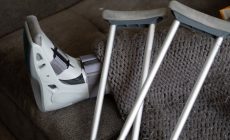Introduction
According to RIDDOR (Reporting of Injuries, Diseases and Dangerous Occurrences Regulations), over 30 million working days are lost each year due to workplace injuries and illnesses in the UK. In order to avoid workplace hazards, emergencies, and crippling lawsuits, employers must ensure that correct safety measures are in place, and adequate first aid training is provided.
Whether you’re an employee or member of staff, being qualified in first aid by taking a first aid course could potentially save a person’s life. From treating minor burns to performing CPR, having the practical skills to deal with health and safety-related incidents will give you the confidence to react assuredly and respond to any situation with professionalism.
What is First Aid at Work?
In accordance with the Health and Safety (First-Aid) Regulations 1981, it is a legal requirement to provide sufficient first aid equipment and services in the workplace, with at least one professionally trained member of staff.
In high-risk workplaces such as construction sites, employees are prone to injuries and accidents if there is no proper training or arrangements in place. Manual labor such as heavy lifting, handling machinery and working in confined places all require precautionary measures, and it is advised to have a trained first aider on the premises at all times. In low-risk workplaces such as offices, there are still many safety factors to consider and risks to be aware of such as trips and falls, electrical hazards and fire hazards.
Workplace First Aid Guide
This step-by-step practical guide to workplace first aid will help you gain a solid understanding of procedures and best practice, in compliance with the UK Government Health and Safety Executive (HSE).
Employer Legal Obligations
- The Health and Safety at Work Regulations 1999 states that all employers must assess risks and take appropriate action to control risks and hazards in the workplace.
- The Health and Safety (First-Aid) Regulations 1981 requires employers to provide sufficient first aid equipment, facilities, and personnel so that any medical emergencies are dealt with professionally and within a quick response time.
- These health and safety regulations apply to all working environments, including the self-employed and companies with less than five employees.
- Appropriate arrangements for administering first aid will vary from workplace to workplace which is why employers must conduct thorough assessments regarding their particular business’s needs.
- Employers who fail to provide adequate first aid and do not comply with health and safety regulations may face prosecution by HSE.
- Under the Reporting of Injuries, Diseases and Dangerous Occurrences Regulations 2013 (RIDDOR), all employers and self-employed workers must report work-related injuries, work-related illnesses, and dangerous hazards.
- It is advised that employers keep a report book. Any incidents reported must be in accordance with the Data Protection Act.
Assessing Workplace First Aid needs
It is crucial that all employers conduct a needs assessment for first aid in the workplace in order to ensure appropriate safety services and training. Assessments must include the type of work that is carried out, the structure of your workforce and staff experience levels. Assessments must include the following checks:
- Active machinery
- Hazardous chemicals and materials
- Uneven flooring
- Confined working spaces
- Electrical hazards
- Slipping, tripping and falling hazards
- Construction/warehouse on-site traffic
- Working areas exposed to harsh weather conditions
What’s in a Basic Workplace First Aid Kit?

In low-risk workplaces such as offices, retail shops, and supermarkets, employers must have a fully-stocked basic first aid kit, to be managed by an appointed first aid supervisor who may or may not have specialist training. In high-risk workplaces, a first aid treatment room with a medical couch and chair may be required.
The first aid supervisor, or whoever is appointed, is responsible for contacting emergency services if required, maintaining equipment and organizing supervision cover if absent. In the case of an emergency, employees must be aware of first-aid arrangements, where first aid facilities are and who is responsible for supervising first aid procedures. According to Alpha Academy, the fundamentals of a basic first aid kit are as follows:
- A first aid booklet
- Individually wrapped waterproof plasters (assorted sizes)
- Sterile eye pads
- Disposable triangular bandages
- Sterile cleansing wipes
- Medium-sized sterile wound dressings
- Disposable medical gloves
- Safety pins
- Microporous tape
Qualified First Aiders and Appointed Supervisors
A ‘first aider’ is someone who has had professional training in first aid, while untrained supervisors are referred to as ‘appointed persons’. Low-risk workplaces with no visible hazards often have appointed persons: however, high-risk working environments require trained first aiders. Appointed persons should not attempt to provide first aid treatment if they do not have the appropriate level of training.
Responsibilities of a first aid supervisor include:
- Taking charge and being the first point of contact when someone is injured or taken ill at work
- Ensuring the injured or sick have access to first aid facilities and equipment
- Requesting the assistance of a qualified first aider if one is available
- Contacting emergency services if required
If your workplace requires a qualified first aider, it is critical as an employer that you choose the right training course. Courses range from nationally recognized qualifications to courses designed by independent providers and emergency services such as the British Red Cross and St. John’s Ambulance.
Workplace first aid training:
If you wish to become a qualified workplace first aider, there are two types of training courses available:
- Emergency First Aid at Work (EFAW) – A level 2 qualification on how to administer first aid treatment in an emergency situation.
- First Aid at Work Certificate (FAW) – A level 3 qualification on how to administer first aid treatment in an emergency situation, including other general first aid treatments.
For low-risk environments:
- At least one appointed first aid supervisor is required for a workforce of up to 25 people.
- At least one qualified EFAW first aider is required per 50 people
- At least one qualified FAW first aider is required per 100 people
For high-risk environments:
- At least one appointed first aid supervisor is required for a workforce of up to 5 people.
- At least one qualified EFAW first aider is required per 25 people
- At least one qualified FAW first aider is required per 50 people
Benefits of Workplace First Aid Training
Regardless of your workplace, first aid services may be required at any time, and it’s crucial to be prepared for any situation, however minor it may be. Some benefits of workplace first aid training include:
Life-Saving Skills

Knowing how to perform CPR and deal with an unresponsive casualty is an invaluable skill to have regardless of whether you’re in a working environment, out and about, or at home. When it comes to serious medical emergencies, having a trained first aider in the workplace who can respond to critical situations quickly and professionally could be the difference between life and death.
A Safe Working Environment for all
Providing workplace first aid training raises employee awareness of health and safety best practices, helping to reduce the number of avoidable accidents and injuries. Staff can feel confident that their wellbeing is safeguarded when there is a trained first aider who is familiar with the first aid kit and guide. Many companies offer first aid training to new employees, and it can even be introduced as a group exercise.
Cost-Effective Classes
First aid training doesn’t cost much when it comes to the value of human life. Ensuring a safe and healthy working environment is money well spent, and training typically lasts less than a week. With basic life support training costing on average £75 at an individual price, there’s really no excuse not to invest in the wellbeing of your staff.
Why do we Need a Workplace First Aid Guide?
Every year, there are over 6,000 workplace-related deaths worldwide and many more injured. From slips and trips to concussions and seizures, it’s vital to be prepared for every scenario, so that employees can receive the immediate attention they need. Employers are therefore responsible for ensuring the safety and wellbeing of their staff by providing adequate first aid training and services.
The Management of Health and Safety at Work Regulations 1999 states that employers must assess, eliminate and control risks to health and safety in the workplace, which means that every organization is required to have a first aid training guide that is in line with the needs of their business.
All businesses should have an emergency plan that includes:
- Evacuation and emergency procedures
- A place of safety
- Nominated advisors to take control of the situation
- A list of the nearest medical facilities
Remember…
First aid facilities are NOT optional in the workplace – it is a mandatory requirement that can lead to severe prosecutions if ignored. Not only does workplace first aid training ensure a healthy working environment, but it also gives employees the assurance they need that their safety and wellbeing is protected. As an employer, it is better to be safe than sorry, and it is your responsibility to have the correct safety measures in place!

























Leave a Reply
Your email address will not be published. Required fields are marked (required)